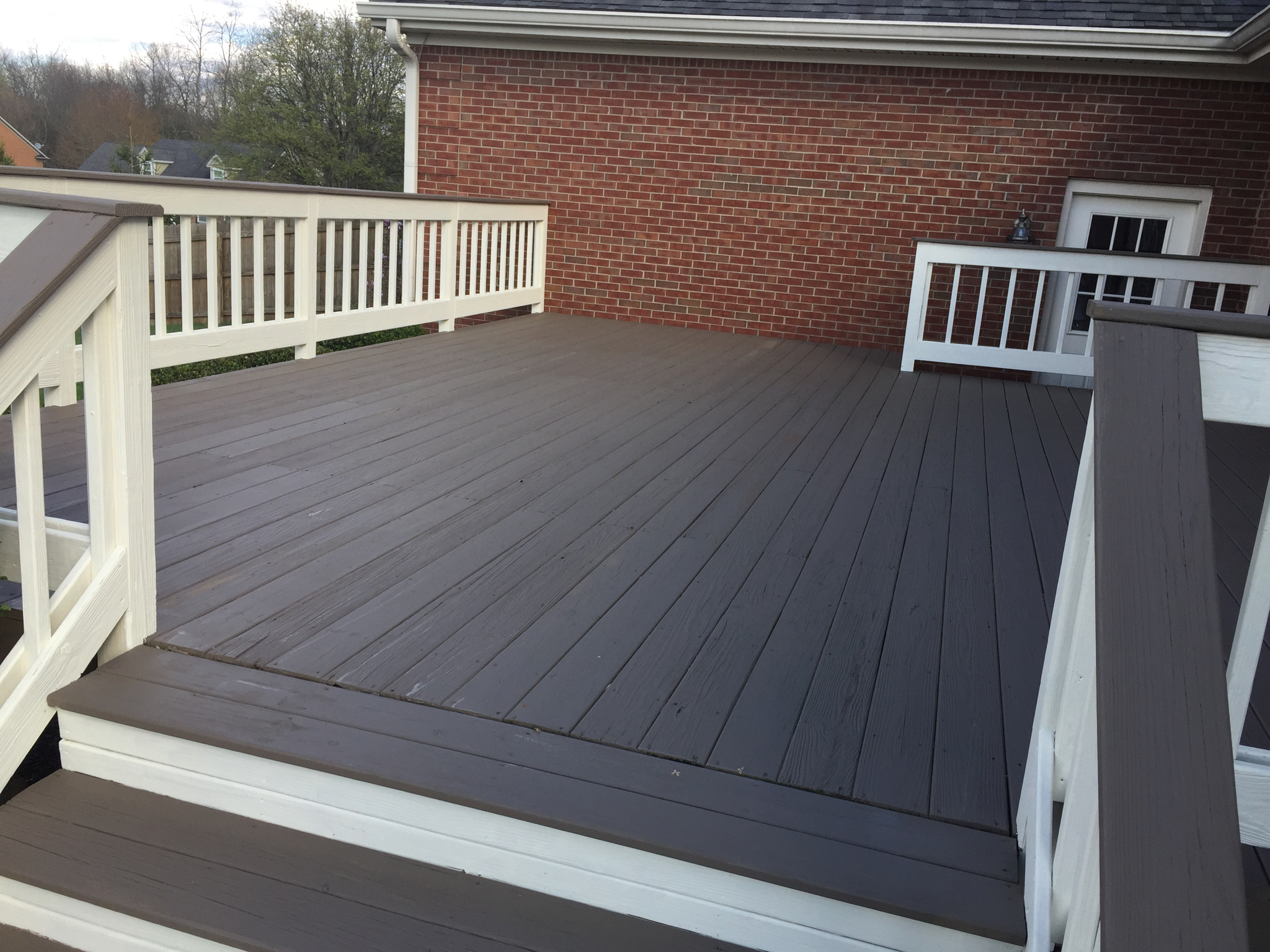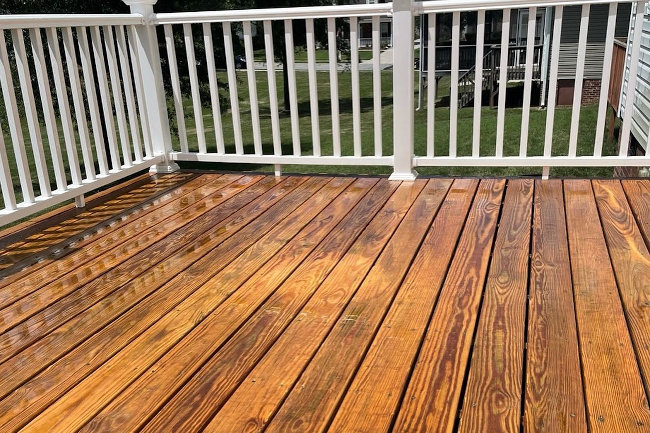Stain Deck for a Resilient End Up: Tips and Techniques
Stain Deck for a Resilient End Up: Tips and Techniques
Blog Article
A Comprehensive Guide to Different Types of Deck Staining Techniques for Ultimate Protection and Aesthetics
In the realm of deck upkeep, the art of tarnishing stands as a pivotal action towards both preserving the integrity of your outdoor space and boosting its visual appeal. As we browse with the complex globe of deck discoloration methods, one starts to appreciate the nuanced techniques that can make all the distinction between a sub-par finish and a remarkable one. From the option of the proper tarnish kind to the careful application methods, each aspect plays an important role in attaining that best equilibrium in between security and aesthetics. Join us as we reveal the secrets behind achieving the supreme deck discoloration results-- a trip where every brushstroke shapes not simply the surface, yet the really significance of your exterior shelter.
Comprehending Various Kinds Of Discolorations
Various kinds of spots are typically used in the procedure of deck staining to accomplish various visual and safety effects. Transparent spots are optimal for showcasing the all-natural grain of the wood while providing marginal defense versus UV rays and moisture. On the other hand, semi-transparent discolorations provide an equilibrium between color improvement and defense, permitting some timber grain to reveal with. For an extra nontransparent surface that supplies maximum protection against the elements, strong discolorations are the preferred choice. These stains can be found in a broad range of shades and effectively hide the timber grain.
In addition, there are also specialized stains such as sealers and printer toners. Toners add a hint of color to the timber while supplying minimal security, making them ideal for newer decks with less wear. Sealants, on the other hand, deal protection against moisture and UV rays without adding color, making them a popular selection for decks that currently flaunt a desirable color. Comprehending the attributes and advantages of each kind of stain is essential for attaining the desired look and sturdiness for your deck.
Picking the Right Spot Shade
When thinking about the looks of your deck discoloration project, the option of stain shade plays a crucial function in enhancing the safety high qualities of the picked discolor type (Right Deck Stain). The shade you choose can considerably influence the total look of your deck, in addition to its capacity to stand up to the components in time
When picking a stain shade, it's necessary to think about the existing color pattern of your home's exterior. Harmonizing the deck stain with the general visual of your residential or commercial property can develop a aesthetically attractive and natural outside area. In addition, the shade of your deck tarnish can affect the temperature level of the deck surface; darker colors have a tendency to soak up even more warm, while lighter shades reflect sunshine and remain cooler.
Furthermore, the sort of wood you are staining will also influence exactly how the tarnish color appears. Various timber types can connect with the tarnish in numerous ways, potentially altering the last shade. It's recommended to test the stain on a little, inconspicuous location of the deck to ensure More Bonuses the color ends up as desired before waging the entire task.
Preparing Your Deck for Discoloration
To make certain a successful and long-lasting deck staining project, thorough prep work of the deck surface is important. Begin by cleaning up the deck completely to eliminate dust, gunk, mildew, and any old tarnish or complete. Utilize a deck cleaner or a mix of water and cleaning agent together with a rigid brush or stress washer to scrub the surface area tidy. After cleaning, permit the deck to dry entirely prior to carrying on to the next step.
Evaluate the deck for any type of harmed or rotten boards that need to be changed. Hammer down any type of protruding nails and sand any type of rough areas to make sure a smooth surface area for discoloration. Look for any type of loosened barriers or actions that might require tightening up or repair work.
When the deck is clean, completely dry, and in good repair, take into consideration using a wood brightener to restore the deck's natural color and open the wood pores for much better discolor infiltration. Secure any type of nearby plants, furniture, or surfaces with plastic bed linen before continuing with the staining process. Appropriate preparation is essential to accomplishing a professional-looking finish and optimizing the longevity of your deck discolor.
Applying Spot With Different Techniques
For a perfect and professional finish, the approach of applying stain plays an essential role in enhancing the appearance and durability of your deck. There are a number of techniques you can make use of to make certain an effective application of tarnish.
Cleaning is a standard method that allows for accuracy and control over the amount of stain applied. It is optimal for intricate areas and getting to in between deck boards (Beautiful Deck). Rolling is a quicker alternative, covering bigger surface successfully. However, back-brushing after rolling is suggested to also out the tarnish and work it into the timber for far better penetration.
Spraying is another prominent strategy, providing rate and ease of application, specifically for big deck areas. Whichever strategy you choose, making sure proper preparation and complying with manufacturer standards will aid accomplish a durable and attractive discolor surface on your deck.

Maintaining and Re-staining Your Deck
Appropriate maintenance and timely re-staining are essential for preserving the elegance and long life of your deck. Normal maintenance tasks consist of sweeping debris, cleansing with a deck cleaner, and examining for any kind of indications of wear or damages. Resolving concerns quickly can prevent much more considerable issues in the future. When it comes to re-staining your deck, the frequency depends on numerous factors such as the sort of tarnish used, the environment in your area, and exactly how much deterioration web your deck experiences. Typically, it is suggested to re-stain your deck every 2-4 years to preserve its protection and aesthetics.
Before re-staining, ensure the deck is tidy, dry, and complimentary of any kind of previous discolor deposit. Pick a top notch stain that fits your deck's material and supplies the preferred level of defense.
Final Thought
Finally, understanding the various kinds of deck discolorations, picking the best shade, appropriately preparing the deck, using discolor with different techniques, and re-staining the deck and preserving are essential actions for ultimate defense and visual appeals. By following these actions, you can ensure view that your deck stays in top condition for years to find.
Additionally, the shade of your deck stain can affect the temperature of the deck surface; darker colors often tend to take in even more heat, while lighter shades mirror sunshine and remain cooler.
It's recommended to test the tarnish on a small, low-profile area of the deck to make sure the shade turns out as preferred prior to continuing with the whole task.

Report this page